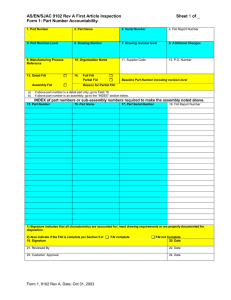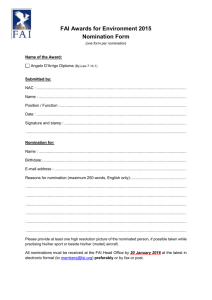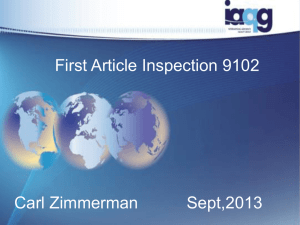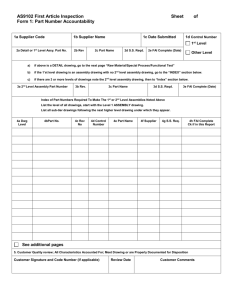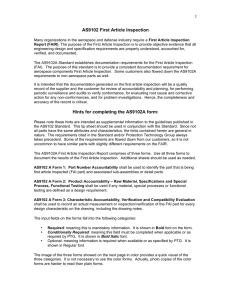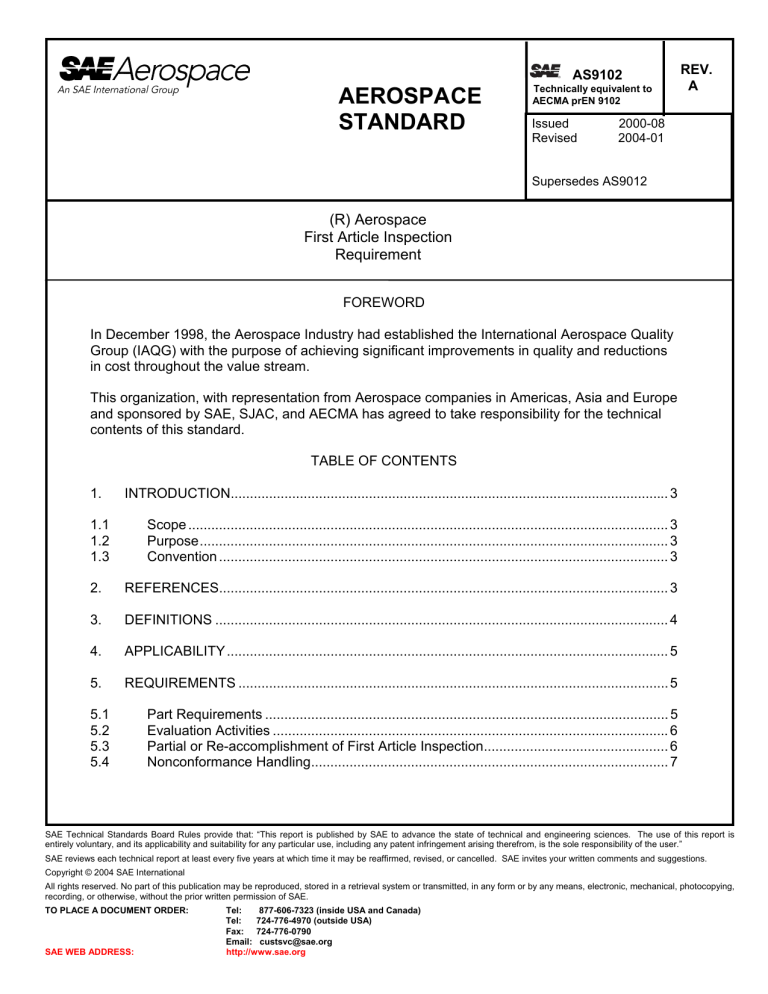
®
AEROSPACE
STANDARD
AS9102
Technically equivalent to
AECMA prEN 9102
Issued
Revised
REV.
A
2000-08
2004-01
Supersedes AS9012
(R) Aerospace
First Article Inspection
Requirement
FOREWORD
In December 1998, the Aerospace Industry had established the International Aerospace Quality
Group (IAQG) with the purpose of achieving significant improvements in quality and reductions
in cost throughout the value stream.
This organization, with representation from Aerospace companies in Americas, Asia and Europe
and sponsored by SAE, SJAC, and AECMA has agreed to take responsibility for the technical
contents of this standard.
TABLE OF CONTENTS
1.
INTRODUCTION.................................................................................................................. 3
1.1
1.2
1.3
Scope ............................................................................................................................. 3
Purpose.......................................................................................................................... 3
Convention ..................................................................................................................... 3
2.
REFERENCES..................................................................................................................... 3
3.
DEFINITIONS ...................................................................................................................... 4
4.
APPLICABILITY ................................................................................................................... 5
5.
REQUIREMENTS ................................................................................................................ 5
5.1
5.2
5.3
5.4
Part Requirements ......................................................................................................... 5
Evaluation Activities ....................................................................................................... 6
Partial or Re-accomplishment of First Article Inspection................................................ 6
Nonconformance Handling............................................................................................. 7
SAE Technical Standards Board Rules provide that: “This report is published by SAE to advance the state of technical and engineering sciences. The use of this report is
entirely voluntary, and its applicability and suitability for any particular use, including any patent infringement arising therefrom, is the sole responsibility of the user.”
SAE reviews each technical report at least every five years at which time it may be reaffirmed, revised, or cancelled. SAE invites your written comments and suggestions.
Copyright © 2004 SAE International
All rights reserved. No part of this publication may be reproduced, stored in a retrieval system or transmitted, in any form or by any means, electronic, mechanical, photocopying,
recording, or otherwise, without the prior written permission of SAE.
TO PLACE A DOCUMENT ORDER:
SAE WEB ADDRESS:
Tel:
877-606-7323 (inside USA and Canada)
Tel:
724-776-4970 (outside USA)
Fax: 724-776-0790
Email: custsvc@sae.org
http://www.sae.org
SAE AS9102 Revision A
5.5
5.5.1
5.5.2
5.5.3
5.6
6.
Documentation ............................................................................................................... 7
Forms ............................................................................................................................. 7
Characteristic Accountability .......................................................................................... 8
Record of Results........................................................................................................... 8
Control of Records ......................................................................................................... 8
NOTES................................................................................................................................. 9
APPENDIX A
FORMS AND GUIDELINES TO COMPLETE THE FORMS ............................ 10
-2-
SAE AS9102 Revision A
1. INTRODUCTION:
1.1
Scope:
This SAE Aerospace Standard (AS) establishes requirements for performing and
documenting the First Article Inspection (FAI).
1.2
Purpose:
The purpose of the First Article Inspection is to give objective evidence that all
engineering, design and specification requirements are correctly understood, accounted
for, verified, and recorded. The purpose of this standard is to provide a consistent
documentation requirement for aerospace components FAI.
1.3
Convention:
The following convention is used in this Standard.
•
The words “shall” and “must” indicate mandatory requirements.
•
The word “should” indicates mandatory requirements with some flexibility allowed in
compliance methodology. An Organization is permitted to show that its approach
meets the intent of the requirement and this standard.
•
Words “typical”, “example” or “e.g.” show suggestions given for guidance only.
•
“Notes” are used for additional clarification.
2. REFERENCES:
1. International Aerospace Standard 9100 “Quality Systems - Aerospace - Model for
Quality Assurance in Design, Development, Production, Installation and Servicing”.
2. International Aerospace Standard 9103 “Variation Management in Key Characteristics”.
3. International Aerospace Standard 9131 “Quality Systems - Nonconformance
Documentation”.
-3-
SAE AS9102 Revision A
3. DEFINITIONS:
ATTRIBUTE DATA: A result from a characteristic or property that is appraised only as to
whether it does or does not conform to a given requirement (for example, go/no-go,
accept/reject, pass/fail, etc.).
DELIVERABLE SOFTWARE: Embedded or loadable airborne, space borne or ground
support software components that are part of an aircraft Type Design, weapon system,
missile or spacecraft.
DESIGN CHARACTERISTICS: Those dimensional, visual, functional, mechanical, and
material features or properties, which describe and constitute the design of the article as
specified by Drawing Requirements. These characteristics can be measured, inspected,
tested, or verified to determine conformance to the design requirements. Dimensional
features include in-process locating features such as target-machined (or forged/cast)
dimensions on forgings and castings, and, weld/braze joint preparation necessary for
acceptance of finished joint. Material features or properties may include processing
variables and sequences, which are specified by the drawing (e.g., heat treat temperature,
fluorescent penetrant class, ultrasonic scans, sequence of welding and heat treat). These
provide assurance of intended characteristics that could not be otherwise defined.
DRAWING REQUIREMENTS: Requirements of the drawing (including Parts Lists),
specification, or purchasing document to which the article is to be made. These include any
notes, specifications, and lower-level drawings invoked.
FIRST ARTICLE INSPECTION (FAI): A complete, independent, and documented physical
and functional inspection process to verify that prescribed production methods have
produced an acceptable item as specified by engineering drawings, planning, purchase
order, engineering specifications, and/or other applicable design documents.
FIRST ARTICLE INSPECTION REPORT (FAIR): The forms and package of documentation
for a part number or assembly, including FAI results, as per this Standard.
FIRST PRODUCTION RUN PARTS: The first group of one or more parts that are the result
of a planned process designed to be used for future production of these same parts.
Prototype parts, or parts built using methods different from those intended for the normal
production process, shall not be considered as part of the first production run.
MULTIPLE CHARACTERISTICS: Identical characteristics that occur at more than one
location (e.g., “4 Places”) but are established by a single set of drawing requirements (e.g.,
rivet hole size, dovetail slots, corner radii, chemical milling pocket thickness).
PRODUCT: The result of a process, which in the context of this Standard includes finished
detailed parts and assemblies. It also includes forgings and castings.
-4-
SAE AS9102 Revision A
3. (Continued):
REFERENCE CHARACTERISTICS: The characteristics that are used for “information only”
or to show relationship. These are dimensions without tolerances and refer to other
dimensions on the drawing.
STANDARD CATALOG HARDWARE: A part or material that conforms to an established
industry or national authority published specification, having all characteristics identified by
text description, National/Military Standard Drawing, or catalog item.
VARIABLES DATA: Quantitative measurements taken on a continuous scale. For example,
the diameter of a cylinder or the gap between mating parts.
4. APPLICABILITY:
This Aerospace Standard applies to assemblies sub-assemblies, and detail parts including
castings and forgings. This Standard applies to organizations that are responsible for
producing the design characteristics of the product. The Organization shall flow down the
requirements of this Standard to Suppliers who produce Design Characteristics.
This Standard does not apply to procured Standard Catalog Hardware or Deliverable
Software.
5. REQUIREMENTS:
5.1
Part Requirements:
The Organization shall perform FAI on new Product representative of the First Production
Run.
NOTE:
For assemblies, the assembly level FAI shall be performed on those
characteristics specified on the assembly drawing.
NOTE:
The Organization shall not use prototype parts, or parts manufactured using
methods different from those intended for the normal production process, for the
FAI. This Standard may be used to verify conformance of a prototype part to
design requirements.
-5-
SAE AS9102 Revision A
5.2
Evaluation Activities:
The Organization should conduct the following activities in support of FAI.
1. Review documentation for the manufacturing process (e.g., routing sheets,
manufacturing/quality plans, manufacturing work instructions, etc.) to make sure all
operations are complete as planned.
2. Review referenced exhibits supporting the FAI (e.g., inspection data, test data,
Acceptance Test Procedures, etc.) for completeness.
3. Review nonconformance documentation (if any), for completeness.
NOTE: International Aerospace Standard 9131 may be used as a guidance.
4. Review material certifications for compliance, as applicable.
5. Verify that approved Special Process sources are used (as applicable), and that the
manufacturing planning/routing document calls out the correct specification.
6. Verify that Key Characteristic requirements have been met, as applicable (see
International Aerospace Standard 9103 for guidance).
7. Verify part specific gages and/or tooling are qualified and traceable, as applicable.
8. Verify that every design characteristic requirement is accounted for, uniquely identified
and has inspection results traceable to each unique identifier.
5.3
Partial or Re-accomplishment of First Article Inspection:
The FAI requirement, once invoked, shall continue to apply even after initial compliance.
The FAI requirements may be satisfied by a partial FAI that addresses differences
between the current configuration and prior approved configurations. When a partial FAI
is performed, the Organization shall complete only the affected fields in the FAI forms.
FAI requirements may also be satisfied by previously approved FAI performed on identical
characteristics of similar parts produced by identical means. When FAI requirements
(partial or complete) are satisfied in this manner, identify the approved configuration in the
index of part numbers on Form 1.
-6-
SAE AS9102 Revision A
5.3
(Continued):
The Organization shall perform a full FAI, or a partial FAI for affected characteristics, when
any of the following events occurs:
1. A change in the design affecting fit, form or function of the part.
2. A change in manufacturing source(s), process(es), inspection method(s), location of
manufacture, tooling or materials, that can potentially affect fit, form or function.
3. A change in numerical control program or translation to another media that can
potentially affect fit, form or function.
4. A natural or man-made event, which may adversely affect the manufacturing process.
5. A lapse in production for two years or as specified by the Customer.
5.4
Nonconformance Handling:
The FAI is not complete until the Organization closes all non-conformances affecting the
part and implements corrective actions. The Organization shall re-do an FAI for those
affected characteristics and shall record the results.
5.5
5.5.1
Documentation:
Forms: The Appendix of this Standard contains forms that comply with the
documentation requirements of this Standard. Each field in the forms is designated with
a unique reference number. Each field is also identified as:
•
(R)
Required: This is mandatory information.
•
(CR)
Conditionally Required: This field must be completed when applicable (i.e.,
when there exists a Customer requirement, then this field must be filled in).
•
(O)
Optional: This field is provided for convenience.
Forms contained in the Appendix should be used to document the results of the FAI.
NOTE:
The fields in the forms are color-coded for convenience. Use of black-andwhite forms is acceptable.
Forms other than those contained in the Appendix may be used, however they must
contain all “Required” and “Conditionally Required” information and have the same field
reference numbers.
-7-
SAE AS9102 Revision A
5.5.1
(Continued):
All forms shall be completed either electronically or in permanent ink.
All forms shall be completed in English or in a language specified by the Customer.
NOTE:
5.5.2
5.5.3
Continuation sheets using the same form are acceptable or insert additional
rows if completing electronically.
Characteristic Accountability: The Organization shall verify every Design Characteristic
during FAI and record the results. Every Design Characteristic shall have its own unique
characteristic number.
NOTE:
Reference characteristics may be omitted from the FAI.
NOTE:
Use more than one line if needed for any characteristic.
NOTE:
Characteristics not measurable in the final product shall be verified during the
manufacturing process (as long as they are not affected by subsequent
operations) or by destructive means. Characteristics verified at the detail level
may be referenced in the assembly-level FAIR.
Record of Results: Results from inspection of design characteristics shall be expressed
in quantitative terms (Variables Data) when a Design Characteristic is expressed by
numerical limits.
The Organization shall record the results in the units specified on the drawing or
specification, unless otherwise approved by the Customer.
Attribute Data (e.g., go/no-go) may be used if no inspection technique resulting in
Variables Data is feasible. Attribute Data is permitted when the Design Characteristic
does not specify numerical limits (e.g., break all sharp edges). It is also permitted where
qualified tooling is consistently used as a check feature and a go/no-go feature has been
established for the specific characteristic.
5.6
Control of Records:
All FAI documentation required by this Standard shall be considered as a quality record
and the Organization shall retain it according to Customer or regulatory requirements.
-8-
SAE AS9102 Revision A
6. NOTES:
6.1
The change bar ( l ) located in the left margin is for the convenience of the user in locating
areas where technical revisions, not editorial changes, have been made to the previous
issue of this document. An (R) symbol to the left of the document title indicates a
complete revision of the document.
PREPARED UNDER THE JURISDICTION OF
SAE COMMITTEE G-14, AMERICAS AEROSPACE QUALITY GROUP (AAQG)
-9-
SAE AS9102 Revision A
APPENDIX A
FORMS AND GUIDELINES TO COMPLETE THE FORMS
This Appendix provides the guidelines to complete the forms. Each input field is identified as:
•
(R)
Required: This is mandatory information. This field is shown in Bold font.
•
(CR)
Conditionally Required: This field must be completed when applicable. This field is
shown in Bold Italic font.
•
(O)
Optional: This field is provided for convenience. It is shown in Regular font.
The fields are also color coded for visual convenience: (R) as yellow and (CR) as blue. Use of
black-and-white forms is acceptable.
- 10 -
SAE AS9102 Revision A
Instructions to Complete Form 1: Part Number Accountability
This form is used to identify the part that is being first-article inspected (FAI part) and associated
subassemblies or detail parts.
NOTE: Fields 1-4 are repeated on all forms for convenience and traceability.
1)
2)
3)
4)
(R)
(R)
(CR)
(O)
5)
(CR)
6)
7)
(CR)
(CR)
8)
(CR)
9)
(R)
10)
11)
(R)
(O)
12)
(O)
13)
14)
(R)
(R)
Part Number: Number of the part (FAI part).
Part Name: Name of the part as shown on the drawing.
Serial number: Serial number of the part.
FAI Report Number: Reference number that identifies the FAI. This may be an
internal report number.
Part Revision Level: Latest part revision that affects the part being first article
inspected. If there is no revision, indicate as such. Note: The latest drawing
revision (Field 7) does not always affect all parts contained on a drawing.
Drawing Number: Drawing number associated with the FAI part.
Drawing Revision Level: The revision level of the engineering drawing. If there
is no revision, indicate as such.
Additional Changes: Provide reference number(s) of any changes that are
incorporated in the product but not reflected in referenced drawing/part revision
level (e.g., change in design, engineering changes, manufacturing changes,
deviation or exclusion from certain drawing requirement, etc.).
Manufacturing Process Reference:
A reference number that provides
traceability to the manufacturing record of the FAI part (e.g., router number,
manufacturing plan number, etc.)
Organization Name: Name of the Organization performing this FAI.
Supplier Code: Supplier Code is a unique number given by Customer to the
Organization. It is sometimes referred to as Vendor Code, Vendor Identification
Number, Supplier Number, etc.
P.O. Number: Enter Customer Purchase Order number, if applicable or required.
Detail part or an Assembly FAI: Check as appropriate .
Full FAI or Partial FAI: Check as appropriate. For a partial FAI, provide the
baseline part number (including revision level) to which this partial FAI is performed
and the reason for it. For example, changes in design, process, manufacturing
location, etc.
15, 16, 17 and 18: This section is required only if the part number in Field 1 is an assembly
requiring lower level parts to be installed into the assembly.
15)
(CR)
16)
17)
18)
(CR)
(CR)
(O)
Part Number: Detail or next level sub-assembly part number to be included in the
assembly.
Part Name , as shown on the drawing.
Part Serial Number of the part that is installed in the assembly, when applicable.
FAI Report Number for detail part.
- 11 -
SAE AS9102 Revision A
19)
(R)
20)
(R)
Signature: Name and signature of the person who prepared FAI Form 1. Also
check appropriate box if this FAI is complete per 5.4.
Note: The signature on this form certifies the following two things:
1) that all characteristics are accounted for; meet drawing requirements or are
properly documented for disposition.
2) if this FAI is complete per 5.4. Check as appropriate.
Date when this FAI Form 1 was prepared.
21)
22)
(O)
(O)
Name of the person from the Organization who approved FAI report
Date when the FAI report is approved.
23)
24)
(O)
(O)
Customer Approval. This field is used by Customer to record approval, if required.
Date Customer approved this FAI form.
- 12 -
SAE AS9102 Revision A
Instructions to Complete Form 2: Product Accountability – Raw Material, Specifications
and Special process(s), Functional Testing
This form is used if any material, special processes or functional testing are defined as a Design
Requirement.
NOTE: Fields 1-4 are repeated on all forms for convenience and traceability.
1)
2)
3)
4)
(R)
(R)
(CR)
(O)
Part Number: Number of the part (FAI part).
Part Name: Name of the part as shown on the drawing.
Part serial number: Serial number of the part.
FAI Report Number: Reference number that identifies the FAI. This may be an
internal report number
5)
6)
(CR)
(CR)
7)
(O)
8)
(CR)
9)
(CR)
10)
(CR)
Material or Process: Enter the name of material or process.
Specification: Enter material or process specifications number (include permitted
alternates, if used), class, and material form (e.g., sheet, bar, etc.). Include all
“Make From” materials that are incorporated into the FAI part. For raw materials,
include all materials that are incorporated into the FAI part, (e.g., weld/braze filler
materials, balls for ball brazing, etc.), and Standard Catalog hardware (e.g., AN,
MS fasteners); but do not include processing materials such as acid etchants.
Code: Enter any required code from the Customer for material or process listing,
when required.
Special Process Supplier Code: Customer given Supplier code of the
organization performing special process(es) or supplying material, as applicable.
Also add, Special process supplier name and address.
Customer Approval Verification: Indicate if the special process or material
source is approved by the Customer. Write NA if Customer approval is not
required.
Certificate of Conformance number: Number of the certificate (e.g., special
process completion certification, raw material test report number, Standard Catalog
hardware compliance report number, traceability number).
11)
(CR)
12)
(CR)
13)
(O)
Comments: As applicable.
14)
15)
(R)
(R)
Prepared By: Name of the person who prepared this form.
Date: Date when this form was completed.
Functional Test Procedure Number: Functional Test Procedure called out as
Design Requirement.
Acceptance Report Number: The functional test certification indicating that test
requirements have been met.
- 13 -
SAE AS9102 Revision A
Instructions to Complete Form 3: Characteristic Accountability, Verification and
Compatibility Evaluation
NOTE: Fields 1-4 are repeated on all forms for convenience and traceability.
1)
2)
3)
4)
(R)
(R)
(CR)
(O)
Part Number: Number of the part (FAI part).
Part Name: Name of the part as shown on the drawing.
Part serial number: Serial number of part.
FAI Report Number: Reference number that identifies the FAI. This may be an
internal report number.
5)
6)
(R)
(CR)
7)
(CR)
8)
(R)
Characteristic Number: Unique assigned number for each Design Characteristic.
Reference Location: Location of the Design Characteristic (e.g., drawing zone
(page number and section), specification, etc.)
Characteristic Designator: If applicable, record characteristic type (e.g., key,
flight safety, critical, major, etc.).
Requirement: Specified requirement for the Design Characteristic (e.g., drawing
dimensional characteristics with nominal and tolerances included, drawing notes,
specification requirements, etc.).
9)
(R)
Results: List measurement(s) obtained for the Design Characteristics.
• For Multiple Characteristics list each characteristic as individual values or list
once with the minimum and maximum of measured values attained. If a
characteristic is found to be non-conforming then that characteristic must be
listed separately with the measured value noted.
• If a Design Requirement requires verification testing, then the actual results will
be recorded on the form. If a laboratory report or certificate of test is included
in the FAIR, then these results need not be written on the form, record the
reference number in this field. The laboratory report or certificate of test must
show specific values for requirements and actual results.
• For metallurgical characteristics with visual verification requirement that are
rated against standard photographs, list the photo number of the closest
comparison. A statement of conformance is acceptable (record the reference
number in this field).
• For processes that require verification per Design Characteristic, include
statement of compliance (e.g., certification of compliance, verification indicator
such as “accept”, etc.).
• For part marking, ensure that marking is legible, correct in content and size and
properly located, per applicable specification.
- 14 -
SAE AS9102 Revision A
10)
(CR)
Designed Tooling: If a specially designed tooling (including NC programming) is
used as a media of inspection, record the tool identification number.
11)
(CR)
Non-Conformance Number: Record a non-conformance document reference
number if the characteristic is found to be non-conforming.
12)
13)
(R)
(R)
Prepared By: Name of the person who prepared this form.
Date: Date when this form was completed.
14)
(O)
This field area is reserved for optional fields. Add additional columns as required
by the Organization or Customer.
- 15 -
SAE AS9102 Revision A
Form 1: Part Number Accountability
Sheet 1 of ___
1. Part Number
2. Part Name
3. Serial Number
4. FAI Report Number
5. Part Revision Level
6. Drawing Number
7. Drawing revision level
8. Additional Changes
9. Manufacturing Process
Reference
10. Organization Name
11. Supplier Code
12. P.O. Number
13. Detail FAI
14.
Assembly FAI
a)
b)
Full FAI
Partial FAI
Baseline Part Number including revision level
Reason for Partial FAI:
if above part number is a detail part only, go to Field 19
if above part number is an assembly, go to the “INDEX” section below.
INDEX of part numbers or sub-assembly numbers required to make the assembly noted above.
15. Part Number
16. Part Name
17. Part Serial Number
18. FAI Report Number
1) Signature indicates that all characteristics are accounted for; meet drawing requirements or are properly documented for
disposition.
2) Also indicate if the FAI is complete per Section 5.4:
19. Signature
FAI complete
FAI not Complete
20. Date
21. Reviewed By
22. Date
23. Customer Approval
24. Date
- 16 -
SAE AS9102 Revision A
Form 2: Product Accountability - Raw Material, Specifications and Special Process(es),
Functional Testing
Sheet 1 of ___
2 Part Name
5. Material or Process
Name
6. Specification
Number
11. Functional Test
Procedure Number
12. Acceptance report number, if applicable
7. Code
8. Special Process
Supplier Code
13. Comments
14. Prepared By
4. FAI Report
Number
3. Serial Number
1. Part Number
15. Date
- 17 -
9. Customer
Approval
Verification
(Yes/No/NA)
10. Certificate of
Conformance
number
SAE AS9102 Revision A
- 18 -

